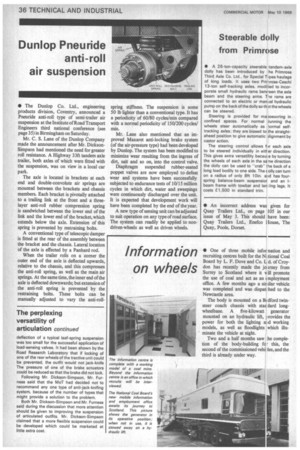Dunlop Pneu ride anti-roll air suspension
Page 38

If you've noticed an error in this article please click here to report it so we can fix it.
• The Dunlop Co. Ltd., engineering products division, Coventry, announced a Pneuride anti-roll type of semi-trailer air suspension at the Institute of Road Transport Engineers third national conference (see page 35) in Birmingham on Saturday.
Mr, C. S. Lane of the Dunlop Company made the announcement after Mr. DicksonSimpson had mentioned the need for greater roll resistance. A Highway 33ft tandem axle trailer, both axles of which were fitted with the suspension, was on view in a local car park.
The axle is located in brackets at each end and double-convolute air springs are mounted between the brackets and chassis members. Each bracket is pivotally attached to a trailing link at the front and a threelayer anti-roll rubber compression spring is sandwiched between the lower end of the link and the lower end of the bracket, which extends below the axle. Extension of this spring is prevented by restraining bolts.
A conventional type of telescopic damper is fitted at the rear of the assembly between the bracket and the chassis. Lateral location of the axle is effected by a Panhard rod.
When the trailer rolls on a corner the outer end of the axle is deflected upwards, relative to the chassis, and this compresses the anti-roll spring, as well as the main air springs. At the same time, the inner end of the axle is deflected downwards; but extension of the anti-roll spring is prevented by the restraining bolts. These bolts can be manually adjusted to vary the anti-roll spring stiffness. The suspension is some 50 lb lighter than a conventional type. It has a periodicity of 60/80 cycles/min compared with a normal periodicity of 150/200 cycles/ min.
Mr. Lane also mentioned that an improved Maxaret anti-locking brake system (of the air-pressure type) had been developed by Dunlop. The system has been modified to minimize wear resulting from the ingress of dirt, salt and so on, into the control valve.
Diaphragm suspended rubber-seated poppet valves are now employed to defeat wear and systems have been successfully subjected to endurance tests of 10/15 million cycles in which dirt, water and sweepings were continuously discharged over the unit. It is expected that development work will have been completed by the end of the year.
A new type of sensing unit can be adjusted to suit operation on any type of road surface. The system can readily be applied to nondriven-wheels as well as driven wheels.












































































































